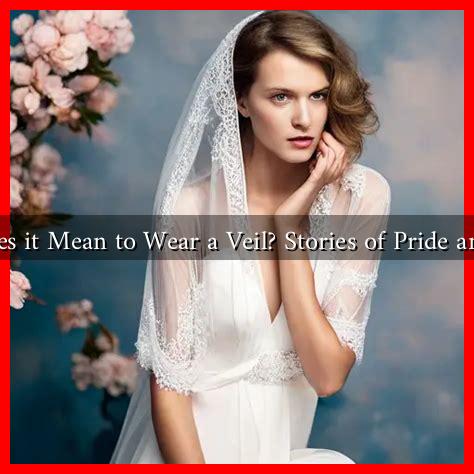-
Table of Contents
What Does it Mean to Wear a Veil? Stories of Pride and Stigma
The act of wearing a veil is a deeply personal choice that varies significantly across cultures, religions, and individual beliefs. For some, it is a symbol of faith and identity, while for others, it may evoke feelings of stigma and discrimination. This article explores the multifaceted meanings of wearing a veil, highlighting stories of pride and the challenges faced by those who choose to don this garment.
The Cultural Significance of Veiling
Veiling practices are prevalent in various cultures and religions, each carrying its own significance. Here are some key points regarding the cultural aspects of veiling:
- Islam: In many Muslim communities, the hijab, niqab, or burqa represents modesty and piety. It is often seen as an expression of faith and a commitment to Islamic principles.
- Judaism: In Orthodox Jewish communities, married women may wear a headscarf or wig (sheitel) as a sign of modesty and marital status.
- Christianity: Some Christian denominations encourage women to wear veils during worship as a sign of respect and submission to God.
- Historical Context: Veiling has been practiced for centuries, with roots in ancient civilizations. It has evolved over time, influenced by social, political, and religious changes.
Stories of Pride: Empowerment Through Veiling
For many women, wearing a veil is an empowering choice that reflects their identity and beliefs. Here are some inspiring stories:
- Fatima’s Journey: A young Muslim woman, Fatima, shares her experience of wearing the hijab as a source of strength. She describes how it connects her to her faith and community, allowing her to express her identity proudly.
- Sarah’s Advocacy: Sarah, an activist, uses her platform to challenge stereotypes about veiled women. She emphasizes that wearing a veil does not define a woman’s capabilities or aspirations.
- Community Support: Many women find solidarity in groups that celebrate veiling as a choice. These communities provide a space for sharing experiences and combating stigma.
The Stigma Surrounding Veiling
Despite the pride many women feel in wearing a veil, there is also a significant stigma attached to it. This stigma can manifest in various ways:
- Discrimination: Veiled women often face discrimination in public spaces, workplaces, and educational institutions. Studies show that they may be perceived as less competent or more radical.
- Media Representation: The portrayal of veiled women in media often leans towards negative stereotypes, reinforcing misconceptions and biases.
- Legal Challenges: In some countries, laws restrict the wearing of veils in public spaces, further marginalizing those who choose to wear them.
Case Studies: Global Perspectives
Examining different countries provides insight into the diverse experiences of veiled women:
- France: The ban on wearing the burqa in public spaces has sparked debates about secularism and religious freedom. Many Muslim women feel alienated and stigmatized as a result.
- Turkey: The lifting of the ban on headscarves in universities has been seen as a victory for women’s rights, allowing many to pursue education without compromising their beliefs.
- United States: In a multicultural society, veiled women often navigate complex identities, balancing their cultural heritage with the challenges of integration.
Conclusion: Embracing Diversity and Understanding
The decision to wear a veil is deeply personal and varies widely among individuals. While it can be a source of pride and empowerment, it is also accompanied by stigma and discrimination. Understanding the diverse meanings behind veiling practices is crucial in fostering a more inclusive society. By listening to the stories of those who wear veils, we can challenge stereotypes and promote acceptance.
Ultimately, embracing diversity in all its forms enriches our communities and helps dismantle the barriers that divide us. As we move forward, it is essential to recognize that the choice to wear a veil is not merely a matter of clothing but a reflection of identity, faith, and personal agency.
For further reading on the topic, you can explore resources from organizations like Human Rights Watch that address issues of discrimination and women’s rights globally.

